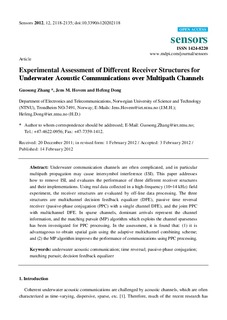| dc.contributor.author | Zhang, Guosong | |
| dc.contributor.author | Hovem, Jens Martin | |
| dc.contributor.author | Dong, Hefeng | |
| dc.date.accessioned | 2015-09-30T08:20:28Z | |
| dc.date.accessioned | 2015-11-11T14:59:30Z | |
| dc.date.available | 2015-09-30T08:20:28Z | |
| dc.date.available | 2015-11-11T14:59:30Z | |
| dc.date.issued | 2012 | |
| dc.identifier.citation | Sensors 2012, 12(2):2118-2135 | nb_NO |
| dc.identifier.issn | 1424-8220 | |
| dc.identifier.uri | http://hdl.handle.net/11250/2360122 | |
| dc.description.abstract | Underwater communication channels are often complicated, and in particular multipath propagation may cause intersymbol interference (ISI). This paper addresses how to remove ISI, and evaluates the performance of three different receiver structures and their implementations. Using real data collected in a high-frequency (10–14 kHz) field experiment, the receiver structures are evaluated by off-line data processing. The three structures are multichannel decision feedback equalizer (DFE), passive time reversal receiver (passive-phase conjugation (PPC) with a single channel DFE), and the joint PPC with multichannel DFE. In sparse channels, dominant arrivals represent the channel information, and the matching pursuit (MP) algorithm which exploits the channel sparseness has been investigated for PPC processing. In the assessment, it is found that: (1) it is advantageous to obtain spatial gain using the adaptive multichannel combining scheme; and (2) the MP algorithm improves the performance of communications using PPC processing. | nb_NO |
| dc.language.iso | eng | nb_NO |
| dc.publisher | MDPI | nb_NO |
| dc.title | Experimental Assessment of Different Receiver Structures for Underwater Acoustic Communications over Multipath Channels | nb_NO |
| dc.type | Journal article | nb_NO |
| dc.type | Peer reviewed | en_GB |
| dc.date.updated | 2015-09-30T08:20:28Z | |
| dc.source.pagenumber | 2118-2135 | nb_NO |
| dc.source.volume | 12 | nb_NO |
| dc.source.journal | Sensors | nb_NO |
| dc.source.issue | 2 | nb_NO |
| dc.identifier.doi | 10.3390/s120202118 | |
| dc.identifier.cristin | 907219 | |
| dc.description.localcode | This is an open access article distributed under the Creative Commons Attribution License (CC BY) which permits unrestricted use, distribution, and reproduction in any medium, provided the original work is properly cited. | nb_NO |
